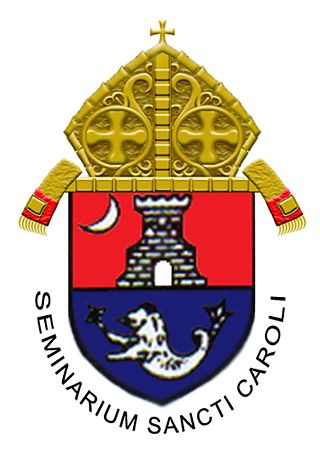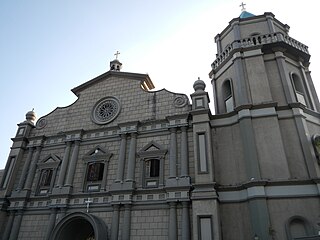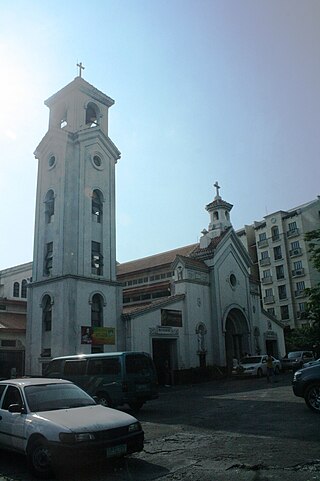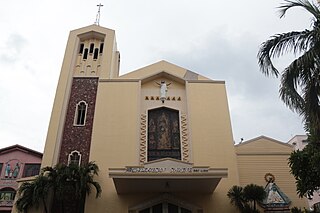
Rufino Jiao Santos was the 29th Archbishop of Manila from February 10, 1953, until his death on September 3, 1973, and was the first Filipino elevated to the rank of cardinal.

The Minor Basilica and Metropolitan Cathedral of the Immaculate Conception, also known as the Manila Cathedral, is a minor basilica located in Intramuros, the historic walled city within today's modern city of Manila, Philippines. It is the cathedral church of the Archdiocese of Manila, dedicated to the Immaculate Conception of the Blessed Virgin Mary as the Patroness of the country.

The Royal and Conciliar San Carlos Seminary is the archdiocesan seminary of the Roman Catholic Archdiocese of Manila. It was established in the year 1702, by decree of King Philip V of Spain. At present, the institution houses seminarians belonging to various dioceses in Luzon, particularly from the Metro Manila region.

William (Wilhelm) Finnemann was a priest of the Society of the Divine Word, auxiliary bishop of Manila and apostolic vicar of Calapan, the Philippines. He was martyred by the Japanese through being thrown into the sea near Verde Island off the coast of Batangas City, Batangas.
Espiritu Santo Parochial School is a basic education institution in Santa Cruz, Manila, with a core of faculty members and staff.

The Immaculate Conception Cathedral of Pasig, locally known as The Pasig Cathedral is the Catholic church located in Plaza Rizal, Barangay Malinao, Pasig in Metro Manila, Philippines. It is the mother church, and the episcopal seat of the Diocese of Pasig and one of the oldest structures in the city.

The Church of the Assumption was founded in 1786, when Captain Francis Light first came to Penang, Malaysia. It is located in Farquhar Street, George Town, within the heritage core zone of the city. The church is the third oldest Catholic church in Malaysia.

The Our Lady of Guidance is a 16th-century image of the Blessed Virgin Mary depicted as the Immaculate Conception and widely venerated by Filipinos. The wooden Black Madonna is considered the oldest extant Marian statue in the Philippines.

Tayuman Street is a four-lane east-west street in northern Manila, Philippines. It stretches 1.6 kilometers (0.99 mi) from the former San Lazaro Hippodrome in Santa Cruz to Barrio Pritil in Tondo district. The street is designated as part of Circumferential Road 2.

Santo Niño de Tondo Parish, also known as Tondo Church, is a Roman Catholic church in Tondo, Manila established by the Augustinians. It houses an image of the Infant Jesus which originally came from Acapulco, Mexico and was handed over by a wealthy merchant to the Archbishop of Manila at that time, who later turned it over to the parish priest of Tondo, Manila. Since 1572, the image of the Santo Niño has been enshrined in this church.

The Roman Catholic church of Orani, declared as an independent parish on April 21, 1714, and also known as Our Lady of the Most Holy Rosary Parish Church is a Neoclassical (heritage) Diocesan Marian Shrine, and Pilgrimage and parish church located in the center of Orani, Bataan in the Philippines.

The Diocesan Shrine and Parish of Our Lady of Light, popularly known as Cainta Church, is a Roman Catholic parish church located along Andres Bonifacio Avenue in Barangay San Andres, Cainta, Rizal, in the Philippines. The church also operates a neighboring school, Cainta Catholic College. From its time of erection as a parish in 1760 until 1983, it belonged to the Archdiocese of Manila. It was placed under the newly created Diocese of Antipolo in 1983, which is now headed by Francisco M. De Leon. It belongs to the Vicariate of Our Lady of Light.

Saint John the Baptist Parish is a 19th-century Roman Catholic church in San Juan, Metro Manila, Philippines. It belongs to the Roman Catholic Archdiocese of Manila.

The Santuario del Santo Cristo, also known as the Church of San Juan del Monte is a church and convento in San Juan, Metro Manila, Philippines. The shrine was built in 1602–1604 by the Dominicans on land that was donated to the order. Both the church and convento were burnt and destroyed during the Chinese insurrection of 1639, and later rebuilt in 1641. It was again destroyed in July 1763 as Britain briefly occupied Manila during the Seven Years' War. The current church and convento were built in 1774, and used as a shelter by Katipuneros during the 1898 Philippine Revolution against the Spanish Empire. It has since been renovated many times until the 1990s.

Santo Domingo Church, formally known as the National Shrine of Our Lady of the Holy Rosary of La Naval de Manila, is a Roman Catholic national shrine and parish church in Quezon City, Metro Manila in the Philippines. Dedicated to Mary, mother of Jesus under her title Our Lady of the Most Holy Rosary — La Naval de Manila, it was founded by the Dominicans in 1587.

The Our Lady of the Pillar Parish Church, commonly known as the Santa Cruz Church and also designated as the Archdiocesan Shrine of the Blessed Sacrament, is a baroque Roman Catholic parish church in the district of Santa Cruz, Manila, Philippines. It was built when the arrabal (suburb) of Santa Cruz was established by the Jesuits in the early 17th century. The church had undergone many repairs and reconstruction, with the last reconstruction done in the 1950s. It is the first mission and motherhouse of Filipino Sacramentinos, making it as the center of congregation activities and events

Sampaloc Church or the Archdiocesan Shrine of Our Lady of Loreto is a Roman Catholic Church located along Figueras Street in the district of Sampaloc in the City of Manila. The church is named after and dedicated to the Virgin Mary and her pilgrimage site in Loreto, Italy where tradition states as the site where the Mary's house was relocated.

La Purisima Concepcion de la Virgen Maria Parish Church, commonly known as Baclayon Church, is a Roman Catholic Church in the municipality of Baclayon, Bohol, Philippines within the jurisdiction of the Roman Catholic Diocese of Tagbilaran. Baclayon was founded by the Jesuit priest Juan de Torres and Gabriel Sánchez in 1596, and became the oldest Christian settlement in Bohol. It was elevated as a parish in 1717 and the present coral stone church was completed in 1737. The Augustinian Recollects succeeded the Jesuits in 1768 and heavily renovated the church since then.

The San Pedro Apostol Parish Church, also known as the Diocesan Shrine of Our Lady of Guadalupe in Extremadura and commonly as Loboc Church, is a Roman Catholic church in the municipality of Loboc, Bohol, Philippines, within the jurisdiction of the Roman Catholic Diocese of Tagbilaran.

The National Shrine of Saint Jude Thaddeus or Saint Jude Parish is one of three Chinese parishes established by the Roman Catholic Archdiocese of Manila in Metro Manila, Philippines.










































